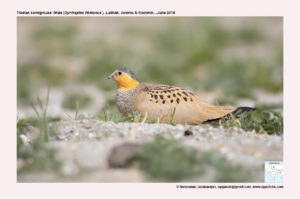Tibetan Sandgrouse

Tibetan Sandgrouse Pterocles tibetanus
Etymology:
- Pterocles :Greek word pteron -wing; kles – notable, splendid
- Tibetanus: From Tibet
Vernacular Names: Ladakh: Kuk, Kaling, Kakeling, Keeling, Tibetan: Kang-ga-ling, Kakali
Distribution in India: Resident of Himalayas in India.
Description: Size of 40 cm; wt. of299–395 g. It has feathered front toes, hind toe lacking feathers and long, pin-like central tail feathers. It has eleven primaries and the tertials are elongate and sharp-tipped. The tail has 16 rectrices, all with pointed tips. The sides of head and throat are orange-yellow, contrasting with finely vermiculated neck and upper breast. The bill is bluish in male, greyish horn in female. Thefemale also differs from male in having narrowly black-barred upperparts, especially tertials and wing-coverts, as well as axillaries, while breast is dark-barred and the central rectrices are less elongated. Thejuvenile is similar to female, with less yellow on sides of head, overall paler plumage, less regular and coarser barring on upperparts, buffy fringes and tips to secondaries, and no yellow on chin and corn-coloured feathers on tarsus and toes.
Habitat: It is found in semi-desert or desert uplands, inhabiting bare, stony plateaux, rocky hillsides, gravelly or sandy river valleys and lacustrine depressions, often at the edge of snowfields, and usually in barren areas with only sparse perennial and annual herbs covering ground. It is found from 3600–6000 m and in winters comes down to 3200 m.
Food habits: It eats buds, flowers and green parts of plants, like legumes. In summer, it eats seeds that have been dug out by snowcocks and Argali sheep.It flies to drink only irregularly, as it acquires sufficient moisture from vegetation and snow.
Breeding habits: They breed in Apr July in Tibet and Himalayas. They are solitary nesters, although still drinks communally throughout breeding season. The nest is scrape among small stones or earth, usually with no lining, but occasionally with some dry grass and feathers, in shelter of a plant, more often on leeward side of ridge or hill. They lay a clutch of 2-3 eggs. The incubation period is 20–24 days and incubation is done by both sexes. The female uses broken-wing display to distract potential predators in vicinity of young.